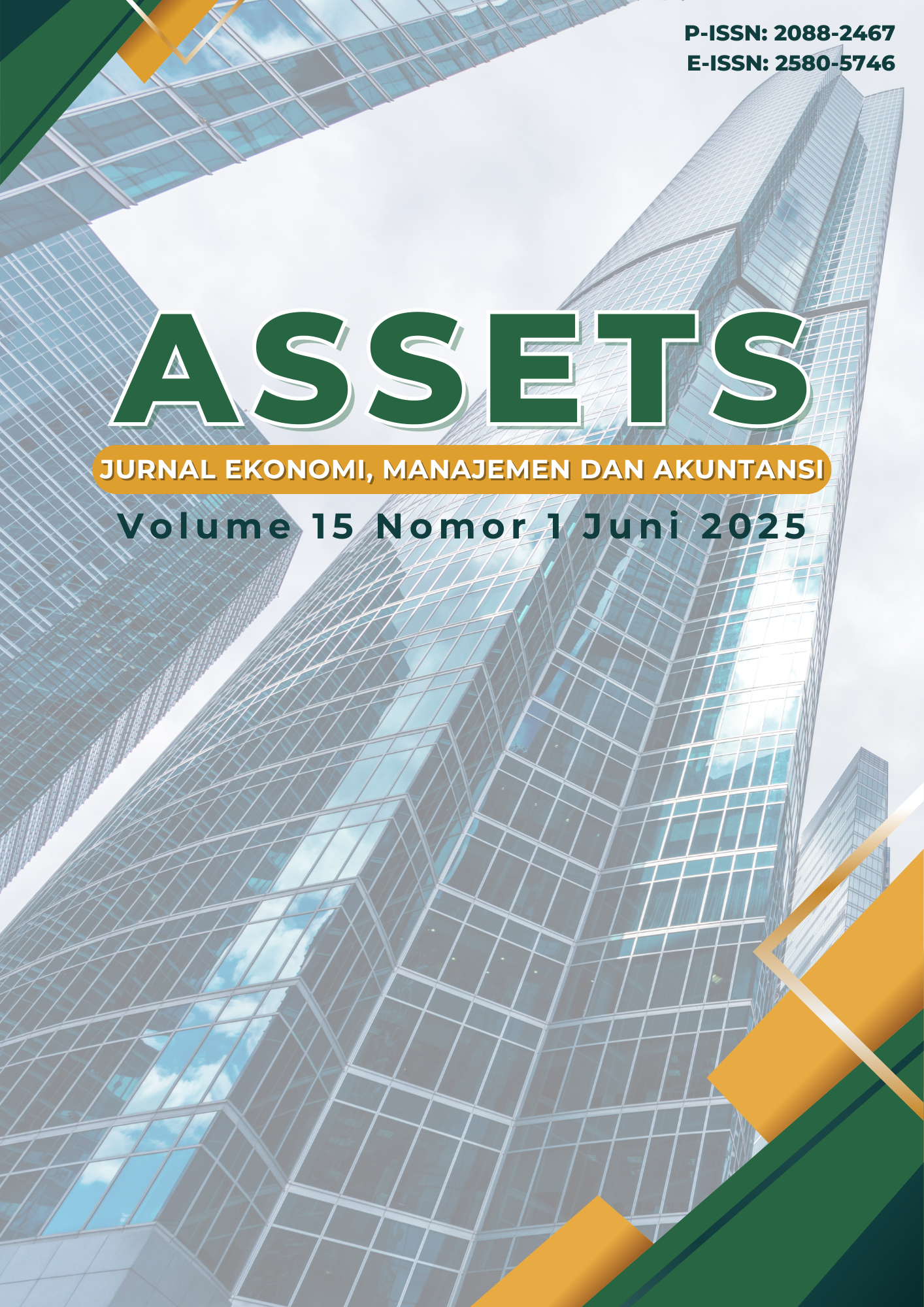OMNI-CHANNEL RETAIL TRANSFORMATION: IMPACTS ON CONSUMER SWITCHING, MARKET BALANCE, AND AGGREGATE DEMAND IN INDONESIA
DOI:
https://doi.org/10.24252/assets.v15i1.57014Keywords:
Omni-channel, consumer switching, market equilibrium, aggregate demand, retail transformationAbstract
This study aims to analyze how the transformation of traditional retail business models to omni-channel models can influence consumer switching behavior, market equilibrium, and aggregate demand. The research method uses descriptive qualitative analysis, with primary and secondary data sources, which are then analyzed through an interactive qualitative model. The results of the study reveal that the adoption of the omni-channel model significantly drives an increase in consumer switching behavior from traditional channels to digital channels. Key factors driving switching include ease of access, service integration, and consistency in the shopping experience. This transformation leads to changes in market structure, where retail players that can adapt experience increased competitiveness, while conventional retail faces declining demand. Overall, aggregate demand shows an increase along with wider market access and improved consumer experiences. The conclusion of this study emphasizes that the shift to an omni-channel business model is not just a trend but a strategic necessity in the face of digital disruption. Retail players are required to continuously innovate to meet the increasingly complex and dynamic expectations of consumers.
References
Jurnal-Jurnal
Bahri, R. S., & Istiharini. (2020). Kajian Literature Strategi Ritel Omnichannel Sebagai Pengembangan Dari Strategi Ritel Multichannel Pada Industri Ritel. Journal of Accounting and Business Studies, 5(2), 69–81. https://doi.org/10.61769/jabs.v5i2.483
Clara, C. (2023). Dimensions of Omnichannel Retail Quality on Customer Satisfaction and Loyalty. Journal of International Conference Proceedings, 6(2), 44–57. https://doi.org/10.32535/jicp.v6i2.2348
Erdanova, S., & Mirzayeva, M. (2023). Aggregate Demand and Aggregate Supply, Their Compositions and Factors Affecting Them. International Journal of Business Diplomacy and Economy, 2(5), 170–177.
Clara, C. (2023). Dimensions of Omnichannel Retail Quality on Customer Satisfaction and Loyalty. Journal of International Conference Proceedings, 6(2), 44–57. https://doi.org/10.32535/jicp.v6i2.2348
Erdanova, S., & Mirzayeva, M. (2023). Aggregate Demand and Aggregate Supply, Their Compositions and Factors Affecting Them. International Journal of Business Diplomacy and Economy, 2(5), 170–177.
Handayani, D. (2020). Penentuan Tarif Digital Parking Dengan Pembatas Kapasitas Berdasarkan Sistem Reservasi Dengan Mempertimbangkan Perubahan Moda Transportasi Pada Kabupaten Sidoarjo. Institut Teknologi Sepuluh November.
Hendrawan, I. (2025). Efektivitas Strategi Omnichannel Toko Kado Shofia dalam Menghadapi Perubahan Perilaku Konsumen. El-Mal: Jurnal Kajian Ekonomi & Bisnis Islam, 6(3), 1369–1378. https://doi.org/1047467/elmal.v6i3.6738
Hickman, E., Kharouf, H., & Sekhon, H. (2020). An Omnichannel Approach To Retailing: Demystifying And Identifying The Factors Influencing An Omnichannel Experience. International Review of Retail, Distribution and Consumer Research, 30(3), 266–288. https://doi.org/10.1080/09593969.2019.1694562
Mimoun, M., Boukhatem, J., & Raies, A. (2024). Aggregate Demand and Inflation Response to Monetary Policy Shocks in Tunisia. Journal of Policy Modeling, 46(3), 592–612. https://doi.org/10.1016/j.jpolmod.2024.01.009
Normawati, R., Widayani, A., & Rachmawati, I. (2023). Consumers’ Intention pada Omni-Channel Matahari dengan Pendekatan Utaut. Pandita: Interdisciplinary Journal of Public Affairs, 5(2), 22–37. https://doi.org/10.61332/ijpa.v5i2.45
Bahri, R. S., & Istiharini. (2020). Kajian Literature Strategi Ritel Omnichannel Sebagai Pengembangan Dari Strategi Ritel Multichannel Pada Industri Ritel. Journal of Accounting and Business Studies, 5(2), 69–81. https://doi.org/10.61769/jabs.v5i2.483
Nurfitri, A. R., Setyaningsih, E., & Winarsih. (2024). Fenomena Bisnis Ritel E-Commerce di Indonesia Serta Dampak dan Peluangnya Terhadap Bisnis Ritel Tradisional. YUME: Journal of Management, 7(3), 1151–1168.
Okviyanti, T., & Kabib, N. (2023). Indonesia’s Economic Growth: Keynes Theory’s Perspective. Ilomata International Journal of Social Science, 4(2), 237–251. https://doi.org/10.52728/ijss.v4i2.729
Rohman, F., Fitriah, L., Ardiyanto, S., & Narendra, B. E. (2024). Analisis Permintaan Agregat dan Penawaran Agregat. Jurnal Akademik Ekonomi Dan Manajemen, 1(4), 282–290.
Salvietti, G., Ziliani, C., Teller, C., Ieva, M., & Ranfagni, S. (2022). Omnichannel Retailing And Post-Pandemic Recovery: Building A Research Agenda. International Journal of Retail and Distribution Management, 50(8), 1156–1181. https://doi.org/10.1108/IJRDM-10-2021-0485
Soelistyo, A. (2022). Macro-Econometric Model: Keynesian-Monetarist Synthesis of the International Balance of Payments (The Indonesian Case). Journal of Economics, Business, & Accountancy Ventura, 25(1), 61–76. https://doi.org/10.14414/jebav.v25i1.2606
Suhartoko, Y., Pratikto, A. P., & Kirana, I. (2022). Ricardian Equivalence in Indonesia. Jurnal Ekonomi Trisakti, 2(1), 167–198. https://doi.org/10.25105/jet.v2i1.13565
Suriansha, R. (2021). Omnichannel Marketing. Journal of Economics and Business UBS, 10(2), 95–109. https://doi.org/10.52644/joeb.v10i2.71
Teixeiraa, A., & Venter, Z. (2023). Macroprudential Policy and Aggregate Demand. International Journal of Central Banking, 1(1), 1–40. https://doi.org/10.1057/9781137439109.0015
Trinh, T. H. (2022). The Extended Theory of Market Equilibrium. Equilibrium, 1(1), 1–17. https://doi.org/10.13140/RG.2.2.32369.15205
Buku-Buku
Chaniago, H. (2021). Manajemen Ritel & Implementasinya. Bandung: Edukasi Riset Digital PT.
Mursyid, & Lamtama. (2020). Dasar-Dasar Ekonomi Mikro. Yogyakarta: BPFE.
Nugraha, J. P., Alfiah, D., Sinulingga, G., Rojiati, U., Saloom, G., Rosmawati, … Beribe, M. F. (2021). Teori Perilaku Perilaku Konsumen. Pekalongan: PT. Nasya Expanding Management.
Wibisono, D. (2024). Marketing 5.0:Mengintegrasikan Teknologi dan Strategi Bisnis Berkelanjutan. Yogyakarta: CV. Bintang Semesta Media.
Downloads
Published
How to Cite
Issue
Section
License

This work is licensed under a Creative Commons Attribution-NonCommercial-ShareAlike 4.0 International License.



























